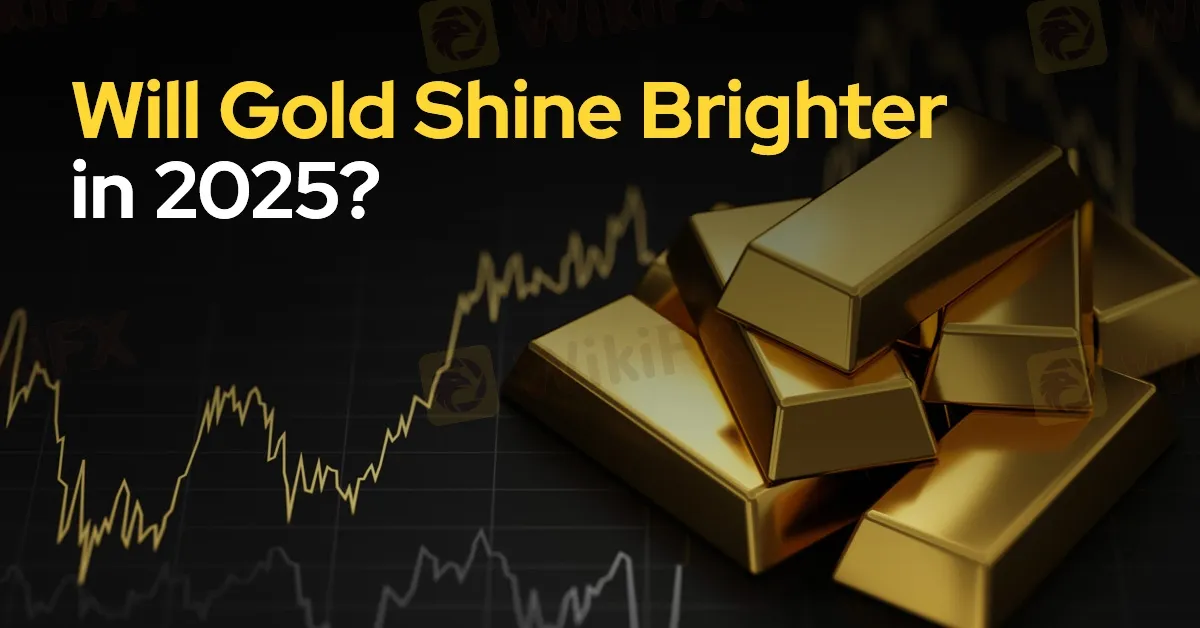简体中文
繁體中文
English
Pусский
日本語
ภาษาไทย
Tiếng Việt
Bahasa Indonesia
Español
हिन्दी
Filippiiniläinen
Français
Deutsch
Português
Türkçe
한국어
العربية
Will Gold Shine Brighter in 2025?
Abstract:Gold is poised for significant gains in 2025, with experts predicting its price to climb between US$2,900 and US$3,000 per ounce or potentially higher. Analysts attribute this optimistic outlook to sustained gold purchases by central banks, ongoing geopolitical tensions, declining global interest rates, and persistent economic uncertainties. These factors, coupled with gold’s status as a hedge against inflation, underline the precious metal’s appeal in volatile times.

Gold is poised for significant gains in 2025, with experts predicting its price to climb between US$2,900 and US$3,000 per ounce or potentially higher. Analysts attribute this optimistic outlook to sustained gold purchases by central banks, ongoing geopolitical tensions, declining global interest rates, and persistent economic uncertainties. These factors, coupled with gold‘s status as a hedge against inflation, underline the precious metal’s appeal in volatile times.
Juwai IQIs chief economist Shan Saeed projects gold prices could rise even further, reaching between US$3,000 and US$5,000 per ounce by next year. He remains confident in gold's long-term performance, describing it as an asset class free of counterparty risk. Shan highlighted that the demand for gold remains robust due to favourable macroeconomic conditions. Citing the World Gold Council, he noted gold prices are expected to grow by an average of 5% annually until 2040. Drawing parallels with the stagflation period of the 1970s, when gold saw average annualised growth exceeding 30%, Shan questioned whether such remarkable growth could be replicated in the current era.

Gold‘s performance in 2024 provides a strong foundation for future optimism. In October, the metal reached an all-time high of US$2,790 per ounce, marking a 35% increase year-to-date before stabilising at around US$2,650. Central banks significantly contributed to this momentum, with India, Turkiye, Poland, and China emerging as major buyers in the first three quarters of the year. India acquired 77 tonnes, Turkiye 72 tonnes, Poland 69 tonnes, and China 30 tonnes, underscoring the global institutional faith in gold’s enduring value.
Investment banks and economists also share this bullish sentiment. UBS targets gold at US$2,900 per ounce by the end of 2025, while Deutsche Bank expects strong physical demand to keep prices steady at around US$2,800. JP Morgan forecasts an average price of US$2,950, citing golds role as a hedge against inflation and economic disruptions. Similarly, OCBC Bank maintains its 12-month target at US$2,900 per ounce.
From a regional perspective, Habib Group executive chairman Datuk Seri Meer Habib highlighted golds reputation as a reliable investment. Despite a slight dip in demand for gold jewellery, investment-grade gold remains highly sought after. Meer anticipates a surge in demand next year, driven by salary increments in Malaysia and global economic trends. He predicts geopolitical tensions in the Middle East and escalating trade disputes between the United States and China will further support gold prices, projecting an increase to US$2,900 per ounce by year-end.
However, Meer acknowledged potential challenges to golds appeal. Rising inflation, subsidy rationalisation in Malaysia, and a strong US dollar could limit demand. He added that a robust stock market might divert investor interest from gold. Furthermore, easing global tensions could reduce the safe-haven demand for gold, which traditionally thrives during periods of uncertainty.
Despite these challenges, gold remains a preferred asset for many investors, offering protection against inflation and economic instability. As the world continues to navigate an unpredictable economic landscape, gold is likely to remain at the forefront of investment strategies in 2025.

Disclaimer:
The views in this article only represent the author's personal views, and do not constitute investment advice on this platform. This platform does not guarantee the accuracy, completeness and timeliness of the information in the article, and will not be liable for any loss caused by the use of or reliance on the information in the article.
Read more

Fidelity Exposed: Traders Complain About Withdrawal Denials, Frozen Accounts & Platform Glitches
Does Fidelity Investments prevent you from accessing funds despite numerous assurances on your requests? Do you witness an account freeze by the US-based forex broker every time you request withdrawal access? Do you struggle with an unstable trading platform here? Is the slow Fidelity customer service making you face forced liquidation? These issues haunt traders, with many of them voicing their frustration on several broker review platforms such as WikiFX. In this Fidelity review article, we have shared quite a few complaints for you to look at. Read on!

Exposing The Trading Pit: Traders Blame the Broker for Unfair Withdrawal Denials & Account Blocks
Did you receive contradictory emails from The Trading Pit, with one approving payout and another rejecting it, citing trading rule violations? Did you purchase multiple trading accounts but receive a payout on only one of them? Did The Trading Pit prop firm refund you for the remaining accounts without clear reasoning? Did you face account bans despite using limited margins and keeping investment risks to a minimum? These are some raging complaints found under The Trading Pit review. We will share some of these complaints in this article. Take a look.

M&G Review: Traders Report Fund Scams, Misleading Market Info & False Return Promises
Applying for multiple withdrawals at M&G Investments but not getting it into your bank account? Do you see the uncredited withdrawal funds out of your forex trading account on the M&G login? Does the customer support service fail to address this trading issue? Does the misleading market information provided on this forex broker’s trading platform make you lose all your invested capital? Were you lured into investing under the promise of guaranteed forex returns? These issues have become highly common for traders at M&G Investments. In this M&G review article, we have echoed investor sentiments through their complaint screenshots. Take a look!

INZO Broker MT5 Review 2025: A Trader's Guide to Features, Fees and Risks
INZO is a foreign exchange (Forex) and Contracts for Difference (CFD) brokerage company that started working in 2021. The company is registered in Saint Vincent and the Grenadines and regulated offshore. It focuses on serving clients around the world by giving them access to popular trading platforms, especially MetaTrader 5 (MT5) and cTrader. The company offers different types of trading instruments, from currency pairs to cryptocurrencies. It aims to help both new and experienced traders. Read on to know more about it.
WikiFX Broker
Latest News
2 Malaysians Arrested in $1 Million Gold Scam Impersonating Singapore Officials
Is FXPesa Regulated? Real User Reviews & Regulation Check
Fraud Mastermind Zhimin Qian Sentenced to 11 Years for $6.6 Billion Bitcoin Ponzi Scheme
Almahfaza Broker – 2025 Review: Safe or Scam?
Uniglobe Markets Review 2025: A Complete Guide to an Unregulated Broker
INZO Broker No Deposit Bonus: A 2025 Deep Dive into Its Offers and Risks
Exness Broker Expands in South Africa with Cape Town Hub
Global Guide to Finding Forex IBs/Brokers — Share Your Pick and Win Big!
Trump tariffs are helping drive U.S. beef prices to new highs
Consob Targets Political Deepfake “Clone Sites” and Unlicensed Platforms in Latest Enforcement Round
Currency Calculator



